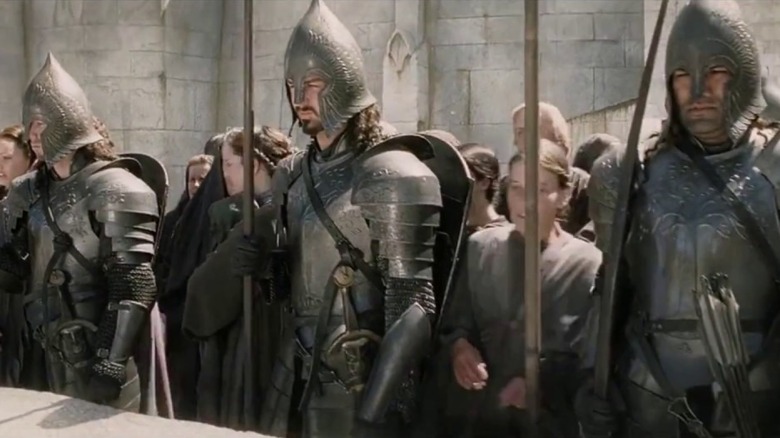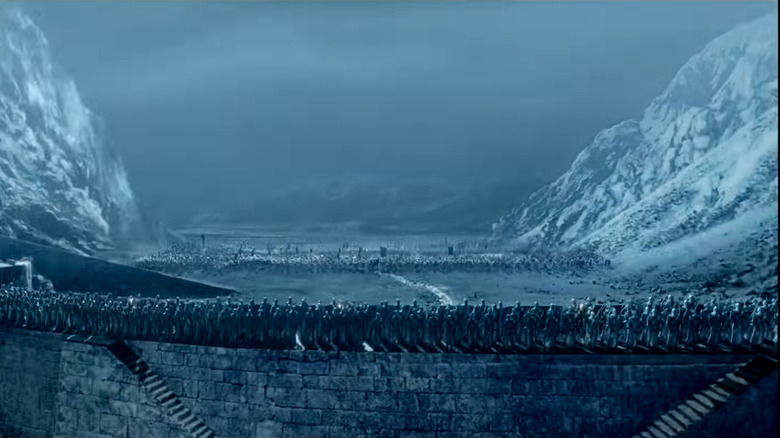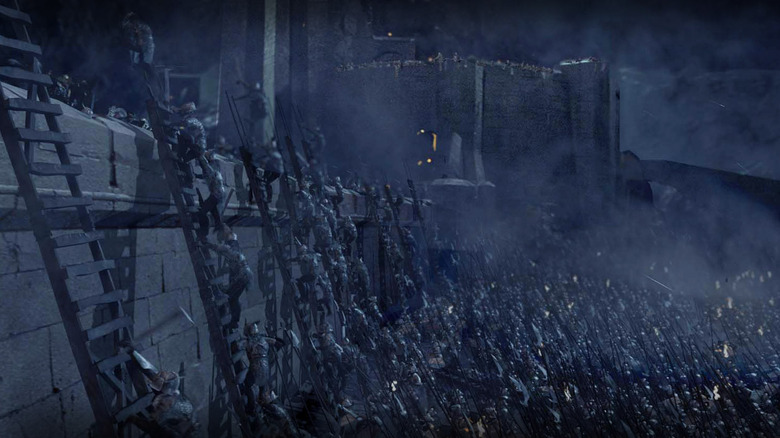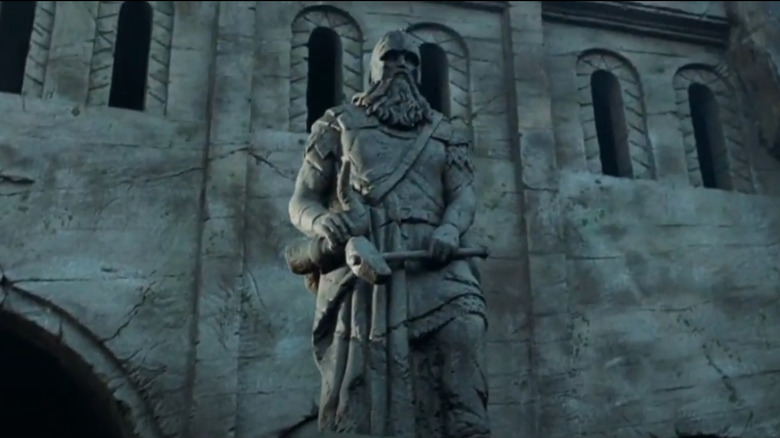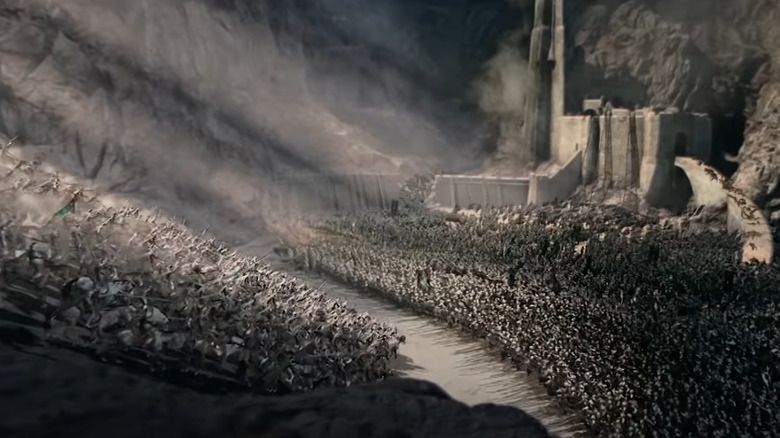The Middle-Earth History Of Helm's Deep
Contains spoilers for "The War of the Rohirrim"
These days, the cinematic world of Middle-earth seems dominated by Amazon Studios. That's why it came as a complete surprise in early June 2021 when Warner Animation and New Line Cinema announced an upcoming "Lord of the Rings" project all their own. The film, titled "The War of the Rohirrim," is going to be an anime feature, which promises to put a new, artistic visual spin on the famous landscape of Tolkien's world. The prequel to the LOTR trilogy is also set in the Third Age, roughly a quarter of a millennium before the War of the Ring. This puts the events of the flick firmly outside of the range of Amazon's series, which is taking place in the Second Age, thousands of years earlier.
As the title implies, the upcoming animated movie will focus heavily on everyone's favorite Horse-lords, the Rohirrim. This promises to dive into some pretty awesome details that surround the history of King Théoden and his people. One of these factoids, as confirmed by Deadline, is that the pic will "expand the untold story behind the fortress of Helm's Deep." Most fairweather fans simply know this location as the imposing structure where Théoden, Aragorn, and company fight a monstrous battle in the film "The Two Towers."
While this is certainly a major moment in the stronghold's history, though, it isn't the biggest one. The seminal event in Helm's Deep's backstory comes 250 years before Legolas and Gimli play "who can kill the most Uruk-hai" and Saruman sees his dreams dashed in one long, bloody night. The citadel's greatest moment will actually unfold during the upcoming movie. With that in mind, we've decided to do a deep dive into the backstory of Helm's Deep to see what makes this bastion of the Rohirrim such a big deal.
The Rohirrim didn't build Helm's Deep
Let's rip this bandaid off quickly, shall we? Yeah, as cool as they are, the Rohirrim aren't the ones who built Helm's Deep. There's no way the equine nation with a history of migration could build something as permanently impressive as Helm's Deep, at least not all on their own. And in this case, the fortress is already fully finished (and even a bit dilapidated) by the time they show up on the scene.
See, the Riddermark, as Rohan is called by its inhabitants, is originally a sparsely populated region of Gondor. At one point, about 500 years before "The Lord of the Rings," the area is invaded and the armies of Gondor do what they do best — they call for aid. In response, an army of mounted "Northmen" rides out of the northeast of Middle-earth and arrives just in the nick of time. They demolish Gondor's enemies and become instant besties with their new Gondorian allies. In return for the nation-saving favor, the Steward of Gondor awards the Northmen, who eventually become known as the Rohirrim, by giving them the entire area to live in.
One portion of this new realm is Helm's Deep. The fortress is already standing and, up until now, it's been garrisoned by Gondorian soldiers. When the land formally becomes Rohan, the Tolkienian book "Unfinished Tales" tells us that "the fortress there was repaired with the aid of masons of Gondor and then committed to the Rohirrim." When the new owners roll in, they initially refer to the strange yet powerful fortress as Súthburg, as it's a fortress in the southern part of the land. See that? "Súth" and "south?" Yeah, Tolkien's names are pretty cool that way.
Helm's Deep is made up of many different parts
Helm's Deep is made up of several different elements, some of which are highlighted in Peter Jackson's films and others that are not. Regardless of whether they already exist in the Middle-earth cinematic universe, though, they're likely to all feature in the new animated film.
The first thing to point out is that Helm's Deep doesn't just refer to the stone building. It's also the name for the local area. In Helm's Deep, there is one structure that literally stands tall above the rest: the Hornburg. This is the tall tower built into one side of the valley. When the Rohirrim first arrive, Tolkien records in "Unfinished Tales" that it's called the "fortress of Aglarond" at the time, but we'll use Hornburg for consistency's sake.
The Hornburg is connected to the Deeping Wall, a long wall that stretches from the fortress across the valley, cutting off the path further into the mountains beyond. In "The Two Towers" book, the Deeping Wall is described as twenty feet high and "so thick that four men could walk abreast along the top." It also adds that it is "sheltered by a parapet over which only a tall man could look" — a likely inspiration for Legolas' "would you like me to find you a box?" line. The front of the wall is described as "smooth, and the great stones of it were set with such skill that no foothold could be found at their joints."
Helm's Dike is another part of the defense, as well, although this one hasn't gotten screen time yet. It's located about a quarter of a mile further down the valley. "The Two Towers" describes this as an "ancient trench and rampart scored across the coomb, two furlongs below Helm's Gate."
There are two major conflicts at Helm's Deep
Helm's Deep is a powerful fortress that stands the test of time. It's founded at some point during the earlier Third Age (which lasts for over 3,000 years) and is still standing when the Rohirrim arrive. Up until that point, we don't know if it had seen any action, but once the Horse-lords take over, there are two distinct conflicts that take place on that location.
The first is the Battle of Helm's Deep. Also called the Battle of the Hornburg, this is the major attack that takes place during "The Two Towers." The Rohirrim and their allies barely come out on top in the desperate fight, and it marks the high-point of Saruman's bid for Middle-earth power.
While the Battle of Helm's Deep is a big deal, it's actually the fight that will be covered in "The War of the Rohirrim" that is what the area is most famous for. See, 250 years before the Battle of Helm's Deep, Rohan is invaded by multiple enemies at the same time. One of these groups is the Dunlendings. These are the same rustic fellows who can be seen swearing a blood oath to Saruman in Peter Jackson's films.
At this earlier point, they're much stronger, and they actually overrun Rohan with their armies. The king at the time is the super-warrior Helm Hammerhand. King Helm is forced to retreat to the Súthburg, where he is besieged and holds out for five long, bitter-cold months which are known as the Long Winter (via Tolkien Gateway).
During that time, Helm builds a fearsome reputation in spite of his difficult circumstances. Eventually, the king dies along with his two sons, and Helm's nephew manages to defeat the Dunlendings and reclaim the throne. The heroic event leads to the fortress and area being named "Helm's Deep" in honor of the fallen king.
Legends surround the fortress
The factual details about the first siege of Helm's Deep are good enough for a movie all on their own. But it's the legends that surround the event that really make it a juicy narrative.
Take, for instance, the vague origin of the structure. While we know that Gondor built it, we don't know how or even when. All we get is the cryptic line in "The Two Towers" that "Men said that in the far-off days of the glory of Gondor the sea-kings had built here this fastness with the hands of giants." The book also gives us the doughty line that the minstrels of Rohan claim that "no foe has ever taken the Hornburg, if men defended it." This gives the fastness a legendary status and a feeling of safety for all of the Rohirrim who ever seek it out in a moment of need.
And then there's Helm's horn. Sharp-eyed fans of the movie will immediately think of Gimli puffing away on a massive instrument right before Théoden and Aragorn make their desperate last charge into the midst of their foes. But that isn't the first time the horn is blown. In "The Two Towers," we discover that the Hornburg is named thus, "for a trumpet sounded upon the tower echoed in the Deep behind, as if armies long-forgotten were issuing to war from the caves beneath the hills."
This harkens back to the story of Helm Hammerhand. During the siege, Helm gets into the habit of leaving his fortress to stalk around his enemy's camp, killing whomever he finds. He always blows the horn first, though, and eventually, his enemies catch on and flee in terror at the sound. From bone-chilling clarions to giant craftsmen to invincible reputations, Helm's Deep is dripping in myths and legends.
Aglarond and the Glittering Caves are a big deal, too
Finally, we have the Glittering Caves. These are the caverns that are located behind the fortress itself where we see the non-warriors of Rohan waiting during the battle in The Two Towers film. The subterranean passages extend further up the mountains, and the first time we really hear about them is in "The Two Towers" book when the commanders are strategizing before the Battle of Helm's Deep. During the discussion, they mention the fact that "there are caves in Helm's Deep where hundreds may lie hid; and secret ways lead thence up onto the hills."
These caves are called Aglarond or the Glittering Caves (via Tolkien Gateway). In "Unfinished Tales," it's explained that Aglarond means "caves of radiance." It also points out that the definition of the Middle-earth word is the same as an impossible to pronounce Anglo-Saxon name that we won't bother to add here. The radiant caverns aren't just pretty chunks of rock, either. They're magnificent underground chambers that are replete with gems, crystals, marbles walls, and veins of precious ores.
In other words, the caverns behind Helm's Deep aren't just caves. They're a natural phenomenon. When Gimli stumbles into them during the battle in "The Two Towers," he's flabbergasted. Shortly afterward, he tells Legolas about them, eloquently describing their hidden wonders and naming them "one of the marvels of the Northern World."
The main history of the Glittering Caves actually comes after "The Lord of the Rings." Gimli returns after the war and brings other Dwarves with him. He oversees the founding of a colony and becomes known as the first "Lord of the Glittering Caves." However, the caves are as old as the mountains themselves, and they remain an integral part of the story of Helm's Deep throughout the long millennia of its history.

